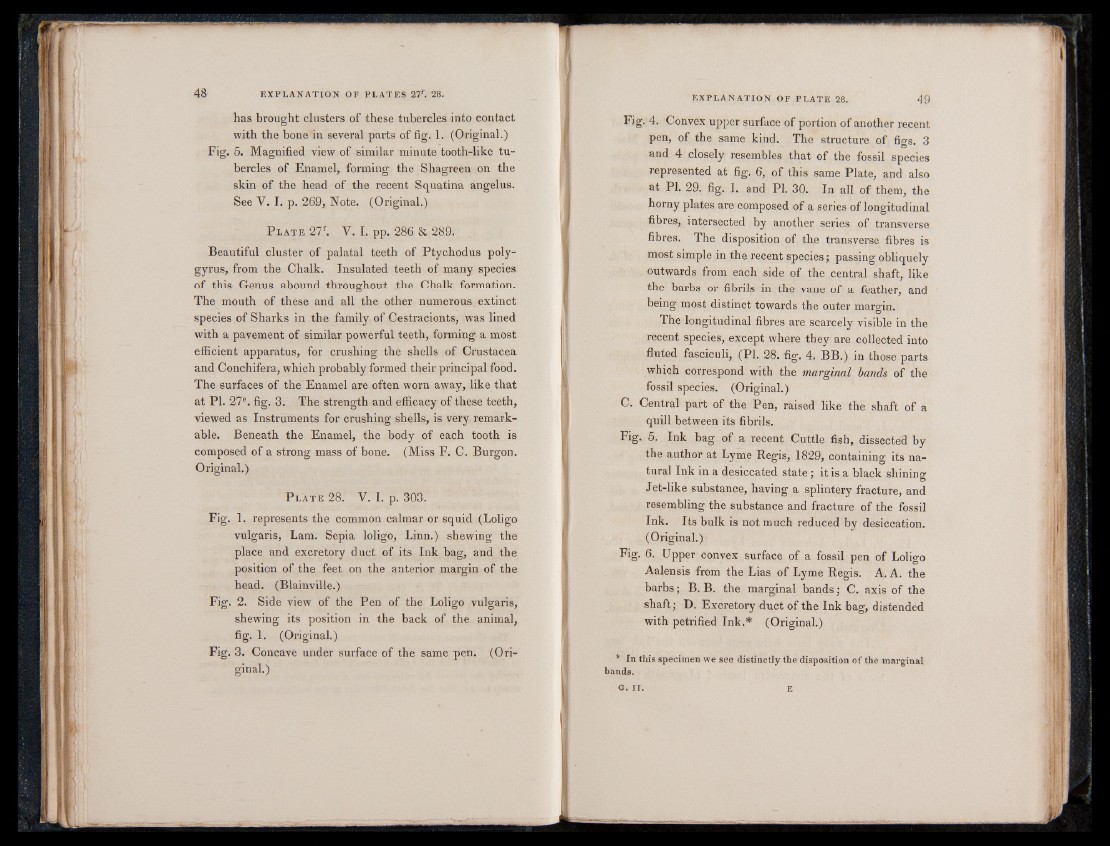
has brought clusters of these tubercles into contact
with the bone in several parts of fig. 1. (Original.)
Fig. 5. Magnified view of similar minute tooth-like tubercles
of Enamel, forming the Shagreen on the
skin of the head of the recent Squatina angelus.
See V. I. p. 269, Note. (Original.)
P late 27f, V. I. pp. 286 8c 289.
Beautiful cluster of palatal teeth of Ptychodus polygyrus,
from the Chalk. Insulated teeth of many species
of this Genus abound throughout the Chalk formation.
The mouth of these and all the other numerous extinct
species of Sharks in the family of Cestracionts, was lined
with a pavement of similar powerful teeth, forming a most
efficient apparatus, for crushing the shells of Crustacea
and Conchifera, which probably formed their principal food.
The surfaces of the Enamel are often worn away, like that
at PI. 27e. fig. 3. The strength and efficacy of these teeth,
viewed as Instruments for crushing shells, is very remarkable.
Beneath the Enamel, the body of each tooth is
composed of a strong mass of bone. (Miss F. C. Burgon.
Original.)
P late 28. V. I. p. 303.
Fig. 1. represents the common calmar or squid (Loligo
vulgaris, Lam. Sepia loligo, Linn.) shewing the
place and excretory duct of its Ink bag, and the
position of the feet on the anterior margin of the
head. (Blainville.)
Fig. 2. Side view of the Pen of the Loligo vulgaris,
shewing its position in the back of the animal,
fig. 1. (Original.)
Fig. 3. Concave under surface of the same pen. (Original.)
explanation of plate 28. 49
Fig. 4. Convex upper surface of portion of another recent
pen, of the same kind. The structure of figs. 3
and 4 closely resembles that of the fossil species
represented at fig. 6, of this same Plate, and also
at PI. 29. fig. 1. and PI. 30. In all of them, the
horny plates are composed of a series of longitudinal
fibres, intersected by another series of transverse
fibres. The disposition of the transverse fibres is
most simple in the recent species; passing obliquely
outwards from each side of the central shaft, like
the barbs or fibrils in the vane of a feather, and
being most distinct towards the outer margin.
The longitudinal fibres are scarcely visible in the
recent species, except where they are collected into
fluted fasciculi, (PI. 28. fig. 4. BB.) in those parts
which correspond with the marginal bands of the
fossil species. (Original.)
C. Central part of the Pen, raised like the shaft of a
quill between its fibrils.
Fig. 5. Ink bag of a recent Cuttle fish, dissected by
the author at Lyme Regis, 1829, containing its natural
Ink in a desiccated state; it is a black shining
Jet-like substance, having a splintery fracture, and
resembling the substance and fracture of the fossil
Ink. Its bulk is not much reduced by desiccation.
(Original.)
Fig. 6. Upper convex surface of a fossil pen of Loligo
Aalensis from the Lias of Lyme Regis. A. A. the
barbs; B. B. the marginal bands; C. axis of the
shaft; D. Excretory duct of the Ink bag, distended
with petrified Ink.# (Original.)
* In this specimen we see distinctly the disposition of the marginal
bands.
6 . II. E